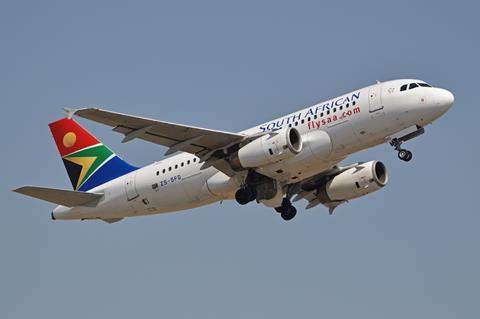South Africa’s government is confident that flag-carrier South African Airways will be able to continue expanding despite the collapse of a long-running effort to sell a majority share to private investors.
Investor consortium Takatso had been set to take a 51% share of the airline, but the two sides have agreed to halt the process some two-and-a-half years after the consortium was selected as a partner.
South Africa’s department of public enterprises says the current government – and the government to be elected during national elections in May – will take steps to “stabilise” the airline.
It adds that a “new form of raising finances” based on SAA’s assets will be explored with financial institutions.
“We are confident that SAA will continue to fly and grow in terms of the number of routes and aircraft that it is able to lease,” the department says.
“SAA now enters a new chapter of its life.”
It has attributed the failure of the drawn-out privatisation to the government’s inability to reach a revised agreement with Takatso, one which would take account of SAA’s increasing value during post-pandemic recovery.

Heavy losses had resulted in SAA’s being placed under business rescue at the end of 2019, just a couple of months before the Covid-19 pandemic began causing extensive economic damage across the air transport sector.
As the troubled carrier was restructured, the government embarked on a strategy to relaunch SAA with an investment partner in order to limit the burden on public funds.
It selected the Takatso consortium in mid-2021 as the preferred partner to take a 51% share of the airline, and a share purchase agreement was reached in February 2022.
But the department of public enterprises states that SAA’s value was assessed during the pandemic – a low point when the carrier was not flying.
This evaluation, it says, was based on asset liquidation methodology. The business itself was consider to be zero value – and potentially negative – and the company overall, when properties were included, was considered to be worth R2.4 billion ($130 million).
But SAA’s return to flight operations and the post-pandemic recovery necessitated a re-examination of the carrier’s value. This reassessment put the business at R1 billion and more than doubled the property total to R5.5 billion.
“It became clear in the negotiations [with Takatso] that the revised transaction structure must take into account public interest and fair market price,” says the department.
“However, these requirements were not met in the renegotiations.”
SAA will proceed as a wholly state-owned carrier as a result of the mutual decision to end the discussions.
The government says it will develop a corporate plan for the airline, which will “embrace more routes and more aircraft”, and aims to strengthen the company’s board in order to support this effort.
“There were lots of lessons to be learned both during the business rescue and in the process of these negotiations,” it adds.
Takatso had comprised African infrastructure investor Harith General Partners and an entity named Global Aviation.
Harith says it had seen the potential acquisition of SAA as an “accelerator” of its strategy to expand its transport platform – which includes aviation assets – and states that, despite the termination of the SAA agreement, it “remains determined” to explore other aviation opportunities.












































